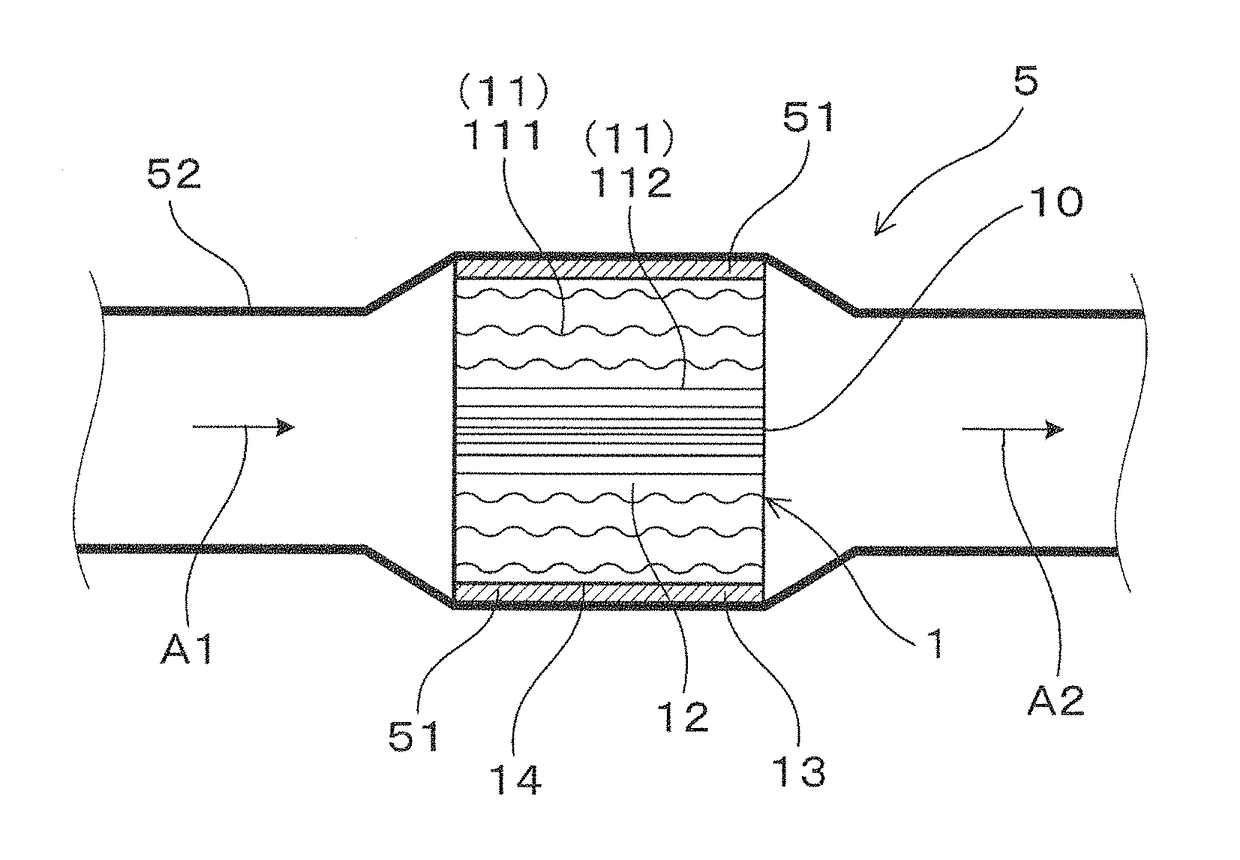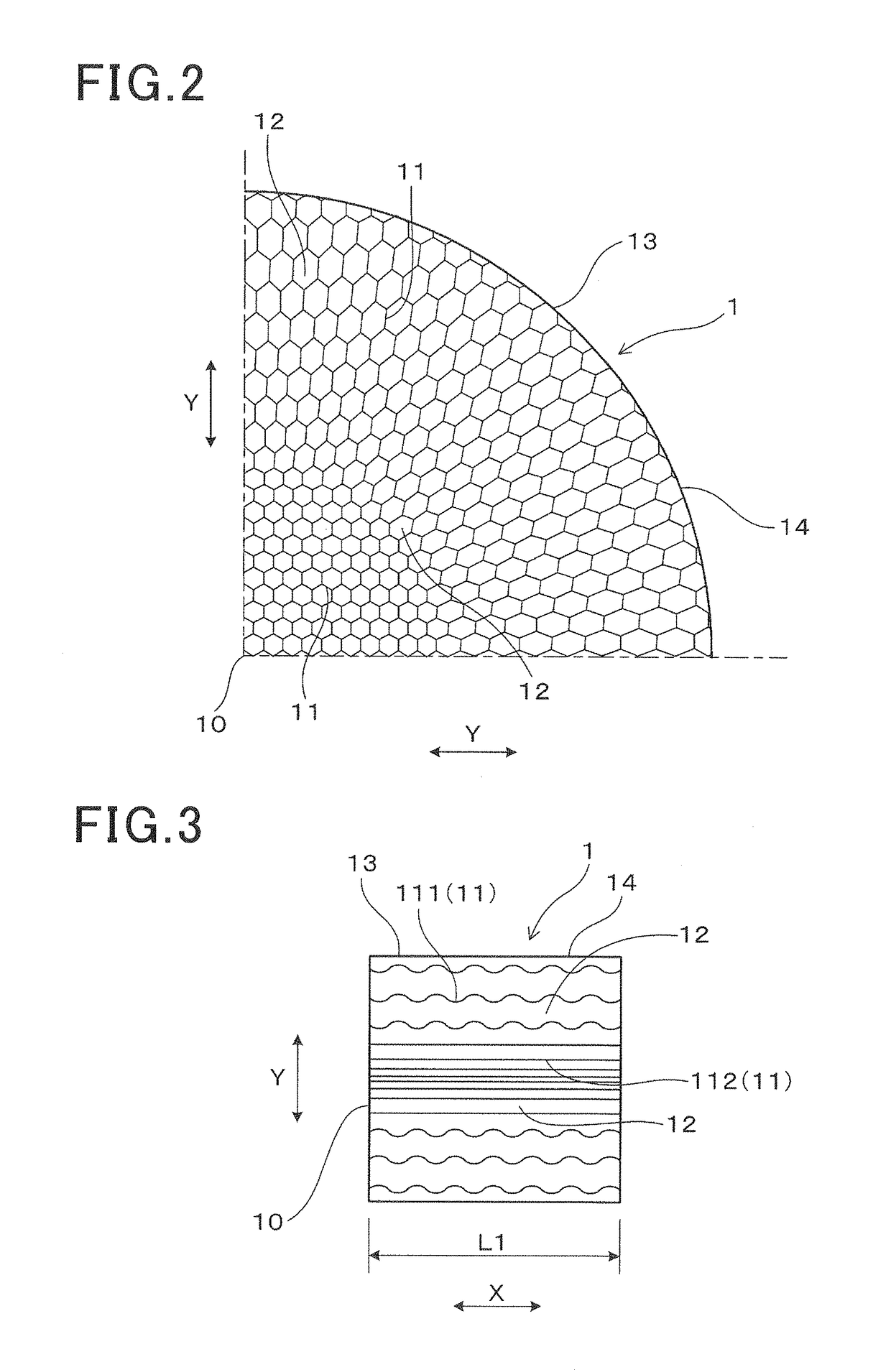Honeycomb structure body
a technology of honeycomb and structure body, which is applied in the direction of domestic applications, machines/engines, and filtration of dispersed particles, can solve the problems of insufficient purification efficiency of exhaust gas in honeycomb structure body, and achieve the effect of reducing variation of exhaust gas purification performance, uniform flow speed of exhaust gas, and reducing the amount of flow
- Summary
- Abstract
- Description
- Claims
- Application Information
AI Technical Summary
Benefits of technology
Problems solved by technology
Method used
Image
Examples
embodiments
First Exemplary Embodiment
[0032]Next, a description will now be given of a plurality of honeycomb structure bodies (sample E1 to sample E3) according to the first exemplary embodiment, and a plurality of honeycomb structure bodies (sample C1 to sample C3) as comparative samples with reference to figures. First, the honeycomb structure body 1 as the sample E1 will be explained.
[0033]As shown in FIG. 1 and FIG. 2, the honeycomb structure body 1 as the sample E1 has cell walls 11 and a plurality of cells 12. The cell walls 11 are arranged in a lattice arrangement to form the cells 12 so that the cell 12 is surrounded by the cell walls 11. The honeycomb structure body 1 has a cell density distribution in which a cell density is reduced continuously or stepwise from the center portion 10 in a radial direction Y to an outer peripheral portion 13. As shown in FIG. 3, the honeycomb structure body 1 has wave shaped cell walls 111 extending in an axial direction X and flat shaped cell walls 1...
second exemplary embodiment
[0057]Next, a description will be given of the honeycomb structure body according to the second exemplary embodiment in which a cell density distribution which is different from that of the honeycomb structure body 1 according to the first exemplary embodiment. A description will now be given of the honeycomb structure body (the samples E4 to E6) according to the second exemplary embodiment and the honeycomb structure body (the sample C4 to C6) as the comparative samples.
[0058]As shown in FIG. 7, similar to the honeycomb structure body according to the first exemplary embodiment, the honeycomb structure body 1 (the samples E4 to E6) has a cell density which is reduced from the center portion 10 to the outer peripheral portion 13 in the radial direction Y. However, the second exemplary embodiment has a cell density which is different in change from the cell density of the first exemplary embodiment.
[0059]FIG. 8 shows a relationship between a distance (mm) measured from the center por...
first experiment
[0068]Next, a description will now be given of the evaluation of each of the honeycomb structure bodies (the samples E1 to E6) according to the first exemplary embodiment and the second exemplary embodiment previously described, and the evaluation of each of the honeycomb structure bodies (the samples C1 to C6) as the comparative samples. The evaluation contents are flow speed distribution, exhaust gas purification performance, pressure loss, and isostatic strength.
[0069]A description will now be given of the method of evaluating the flow speed distribution, the exhaust gas purification performance, the pressure loss and the isostatic strength.
[Evaluation of Flow Speed Distribution]
[0070]As shown in FIG. 9, a catalyst converter 8 was arranged in the inside of an exhaust gas pipe 52. The catalyst converter 8 was equipped with the honeycomb structure body 1 which was covered with aluminum sheet. The honeycomb structure body 1 supported catalyst therein in order to purifying exhaust ga...
PUM
| Property | Measurement | Unit |
|---|---|---|
| length | aaaaa | aaaaa |
| length | aaaaa | aaaaa |
| thickness | aaaaa | aaaaa |
Abstract
Description
Claims
Application Information
 Login to View More
Login to View More - R&D
- Intellectual Property
- Life Sciences
- Materials
- Tech Scout
- Unparalleled Data Quality
- Higher Quality Content
- 60% Fewer Hallucinations
Browse by: Latest US Patents, China's latest patents, Technical Efficacy Thesaurus, Application Domain, Technology Topic, Popular Technical Reports.
© 2025 PatSnap. All rights reserved.Legal|Privacy policy|Modern Slavery Act Transparency Statement|Sitemap|About US| Contact US: help@patsnap.com



